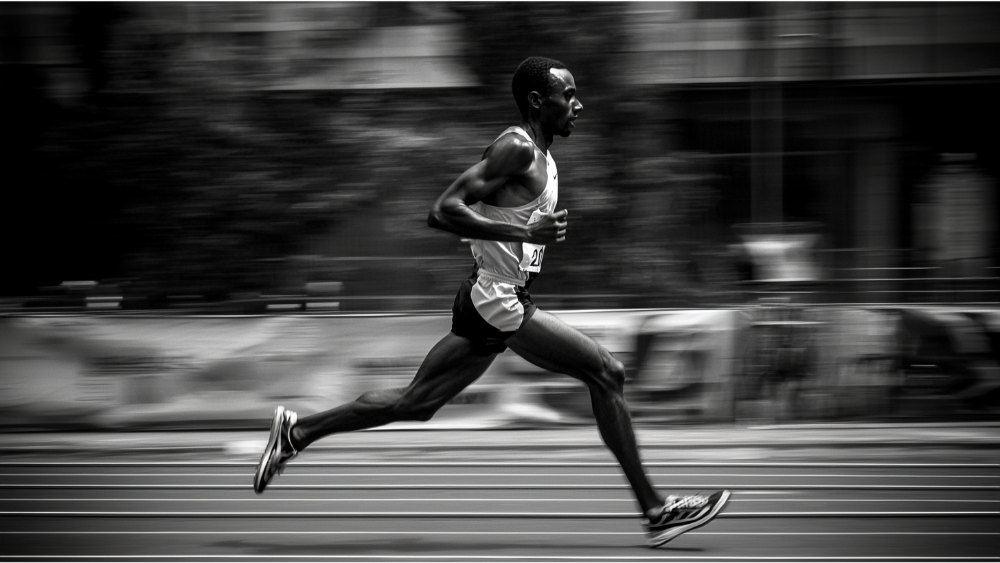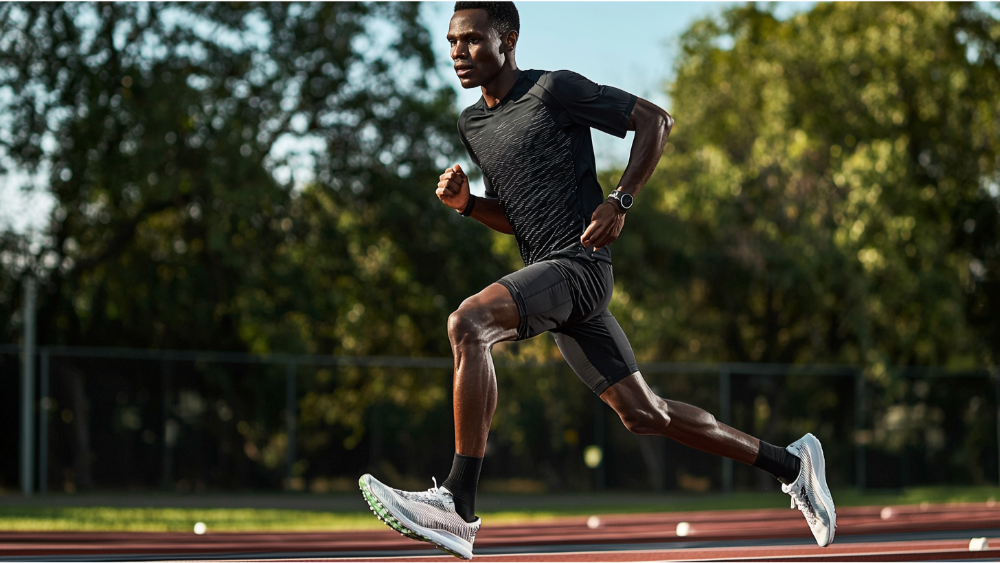Running faster isn’t just about moving your legs quicker—it’s about optimizing your body’s efficiency, following a strategic training plan, and adopting a holistic approach that includes nutrition, recovery, and mindset. Whether you’re an athlete or a casual runner, the following guide will equip you with the tools to shave seconds (or minutes) off your times.
Optimize Your Running Form
Efficient running is crucial for boosting speed and performance. Poor form not only wastes energy but also leads to increased fatigue and a higher risk of injury. By focusing on proper running mechanics, you can maximize each stride’s effectiveness. Studies highlight that refining your technique significantly improves speed and endurance, ensuring every step contributes to your success.
Key Elements of Running Form
Maintaining a tall, upright posture with a slight forward lean propels you forward efficiently while minimizing strain on your back and neck. Keeping your chest open ensures better oxygen intake, supporting endurance and performance. Avoid slouching to maintain proper alignment, which not only improves breathing but also enhances your overall running efficiency and comfort.
Arms
Your arms play a vital role in maintaining rhythm, balance, and efficiency during running. Keep them bent at a 90-degree angle, swinging them forward and back in a straight line without crossing your body. This proper arm movement generates momentum, stabilizes your stride, and synchronizes your movements, improving overall mechanics. By mastering this technique, you can enhance your running efficiency, reduce energy waste, and achieve better speed and endurance.
Foot Strike
Focus on landing on your midfoot rather than your heel while running. A midfoot strike helps reduce the impact on your joints, improving overall comfort and minimizing the risk of injuries. This technique also facilitates a smoother, quicker transition into your next stride, enhancing both speed and efficiency. By adopting a midfoot strike, you can maximize your running performance and maintain better control with each step.
Cadence and Stride
An optimal cadence of about 180 steps per minute reduces ground contact time and minimizes energy loss. You can measure your cadence by counting steps for 30 seconds and doubling the number.
Stride Length
Long strides may seem faster, but overextending can cause inefficiencies. Focus on a stride length that feels natural and maintains consistent forward momentum.
Effective Training Strategies to Boost Speed

Interval Training
Interval training alternates short bursts of high-intensity running with recovery periods. For example, sprint for 30 seconds at maximum effort, then jog or walk for 90 seconds. Repeat this cycle 6–10 times. This method builds speed and endurance simultaneously.
Tempo Runs
Tempo runs involve running at a “comfortably hard” pace for an extended period, usually 20–40 minutes. This helps improve your lactate threshold, enabling you to sustain faster speeds for longer.
Hill Training
Uphill running builds strength in your glutes, quads, and calves while boosting cardiovascular fitness. This training enhances stride power, enabling greater efficiency and speed on flat terrain. Incorporating hill workouts into your routine develops strength, endurance, and explosive power, ultimately improving your overall running performance and pace.
Sample Hill Workout Plan
- Warm-up with 10 minutes of light jogging.
- Sprint uphill for 20–30 seconds at 90% effort.
- Walk or jog back down to recover.
- Repeat 8–10 times.
Long Runs and Endurance
Developing a strong aerobic base with weekly long runs enhances stamina for faster-paced efforts. Maintain a steady, conversational pace during these runs to build endurance and improve cardiovascular fitness. Consistent long-distance training lays the foundation for sustained speed and overall running performance.
Strength Training for Runners
Core Strength
Building a strong core is essential for stabilizing your body, minimizing fatigue, and reducing the risk of injuries. Incorporate exercises like planks, side planks, and bridges into your routine to develop core strength, enhance balance, and improve overall running efficiency and endurance. A solid core supports long-term performance.
Lower Body
Focus on strengthening your glutes, hamstrings, and calves through exercises like squats, lunges, and step-ups to build a solid foundation for running. Incorporate plyometric drills such as box jumps to enhance explosive power, improve stride efficiency, and boost your overall athletic performance for better speed and endurance.
Upper Body
Pay attention to your upper body—strong arms and shoulders contribute to better balance and improved running mechanics. Incorporating upper-body strength training enhances overall performance, making each stride more efficient and reducing the risk of imbalances.
Nutrition and Hydration for Speed

- Carbohydrates: Your body’s primary energy source during running. Focus on complex carbs like whole grains, sweet potatoes, and oats.
- Proteins: Essential for muscle recovery and repair. Include lean proteins like chicken, fish, and beans.
- Fats: Provide long-lasting energy for endurance runs. Incorporate healthy fats like avocados, nuts, and olive oil.
Pre-Run Nutrition
Consume a light, carb-rich snack low in fat 2–3 hours before running. Good options include a banana with peanut butter or a small bowl of oatmeal, providing energy while avoiding discomfort during your workout.
Hydration Tips
Dehydration hampers performance, leading to fatigue and muscle cramps. Maintain hydration by drinking water steadily throughout the day, ensuring your body functions optimally and is prepared for physical activity without the risks of exhaustion or discomfort.
Electrolytes
During runs exceeding an hour, opt for electrolyte-rich beverages to replace essential minerals like sodium, potassium, and magnesium lost through sweat. These drinks support hydration, prevent cramping, and help maintain energy levels for sustained performance.
Recovery Techniques to Sustain Progress
Active Recovery
Include low-impact activities such as walking, cycling, or yoga on rest days to boost blood circulation and support muscle recovery. These gentle exercises enhance relaxation, prevent stiffness, and help your body prepare for the next training session.
Sleep
Getting 7–9 hours of quality sleep each night is essential for recovery. Sleep allows your body to repair, rebuild strength, and restore energy, ensuring optimal performance and reducing the risk of fatigue or injury during training.
Tools for Recovery
Foam Rolling
Foam rolling relieves muscle tightness and enhances mobility by targeting key areas like the quads, hamstrings, and calves. This recovery technique promotes better flexibility and circulation, preparing your body for optimal performance and reducing the risk of injury.
Massage and Percussion Devices
These tools offer deep tissue relief, reducing soreness and preventing stiffness after intense runs. They enhance recovery by targeting tight muscles, promoting relaxation, and improving mobility, ensuring you’re ready for your next training session with ease.
Mental Strategies for Running Faster

Setting SMART Goals
Set SMART goals: specific, measurable, achievable, relevant, and time-bound objectives. This approach helps you monitor progress, stay focused, and maintain motivation, ensuring your efforts align with your aspirations and lead to meaningful, attainable results.
Visualization Techniques
Picture yourself running with speed and strength. Visualization enhances confidence and sharpens focus, mentally preparing you for top performance. This technique helps you stay motivated and align your mindset with your goals, setting the stage for success.
Overcoming Mental Barriers
Overcome discomfort by dividing your run into manageable milestones. Acknowledge and celebrate each small achievement along the way to maintain motivation and build confidence, especially during tough sessions. This approach keeps you focused and energized to reach your goals.
Common Mistakes to Avoid

Overtraining
Overtraining without proper rest can lead to physical fatigue, burnout, and injuries, ultimately hindering your progress and long-term performance. Your body needs time to repair and strengthen after intense workouts, making recovery an essential part of any training plan. Ignoring the signs of overexertion, such as persistent soreness, fatigue, or decreased performance, can result in setbacks that take weeks or months to recover from. Incorporating rest days and active recovery sessions, like light stretching or yoga, allows your muscles to heal while maintaining mobility. Listen to your body, prioritize rest, and remember that consistent progress comes from a balance between effort and recovery.
Poor Shoe Choices
Choosing the wrong running shoes can hinder your performance and significantly increase your risk of injury. Ill-fitting or unsupportive footwear may lead to discomfort, blisters, or long-term issues like joint pain or plantar fasciitis. To maximize your speed and safety, invest in high-quality running shoes designed to match your foot type, stride, and running surface. Visit a specialized store for a professional fitting, and consider factors such as arch support, cushioning, and stability. Regularly replace your shoes as they wear out to maintain optimal support. Proper footwear not only enhances your running efficiency but also protects your body from unnecessary strain.
Ignoring Warm-Ups and Cool-Downs
Neglecting warm-ups and cool-downs can result in muscle stiffness, reduced flexibility, and a higher risk of injuries. A proper dynamic warm-up is essential to prepare your body for physical activity by increasing blood flow, improving mobility, and activating muscles. Similarly, a cool-down session helps your body transition back to a resting state, reducing soreness and promoting recovery. Stretching during the cool-down aids in maintaining flexibility and preventing tightness. Skipping these critical steps can impair your performance and recovery over time. Incorporate both into your routine to enhance your workout efficiency, prevent injuries, and support overall muscular health and performance.
Conclusion
Improving your running speed is a journey that requires dedication, consistency, and a multifaceted approach. By optimizing your form, incorporating targeted training, focusing on nutrition, and prioritizing recovery, you’ll be well on your way to reaching your running goals. Implement these strategies gradually, and remember that progress takes time—stay committed, and the results will follow.

Leave a Reply